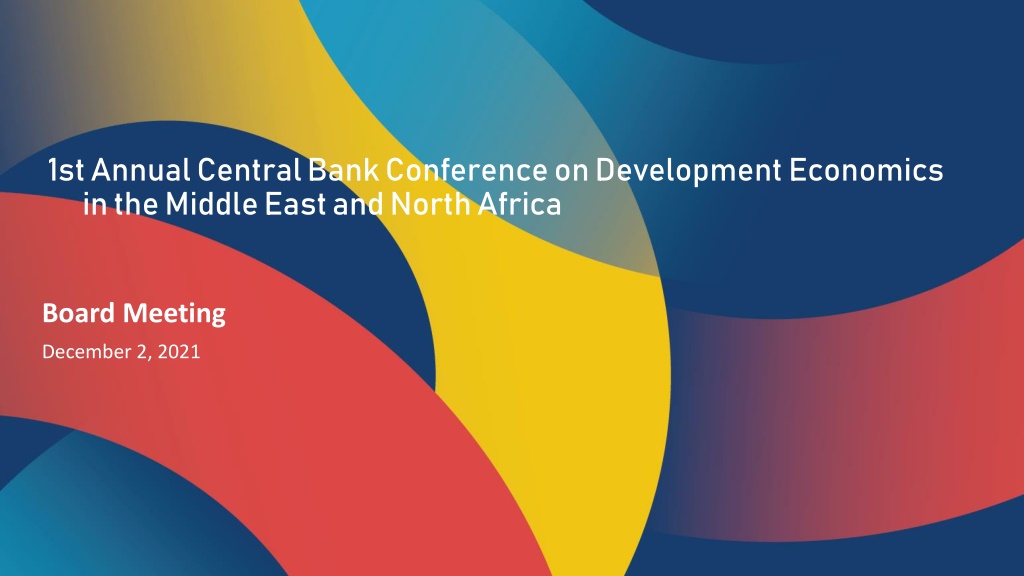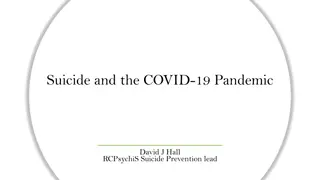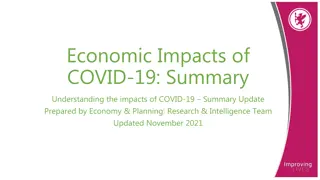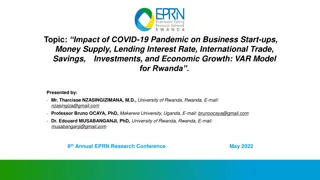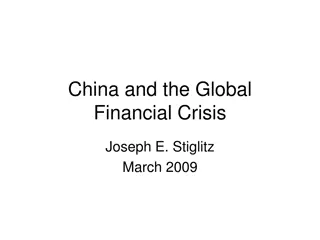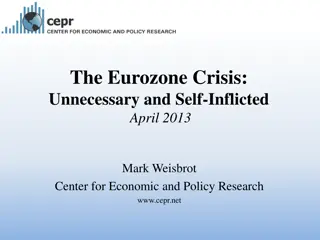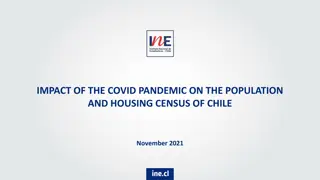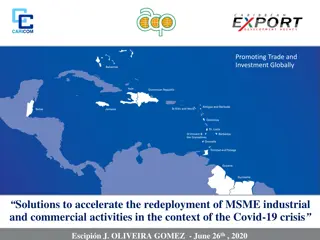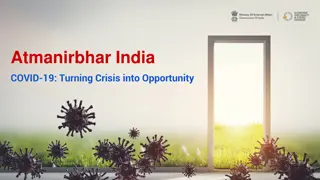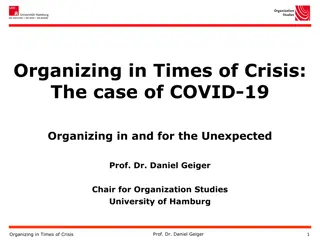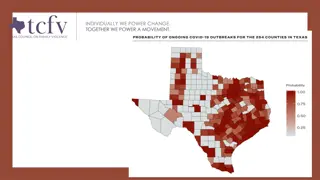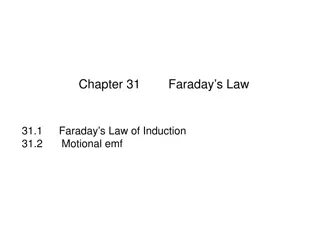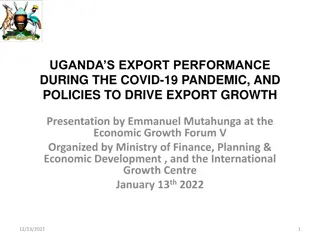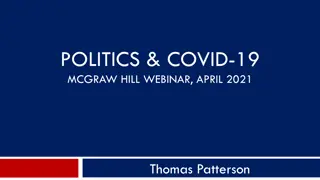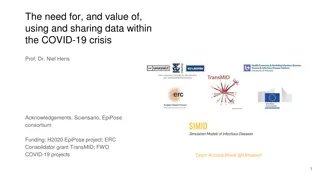The Global Economic Crisis Induced by the Covid-19 Pandemic in Historical Perspective
The economic crisis triggered by the Covid-19 pandemic in 2020 had far-reaching global implications, with 95% of countries experiencing negative output growth. Unlike past crises, this crisis stemmed from a self-induced supply shock, impacting households and firms worldwide. The pandemic led to a rise in poverty levels and exacerbated inequalities within and among nations. The World Development Report 2022 emphasizes the need for equitable financial strategies to address loan distress and debt restructuring in order to facilitate a sustainable recovery.
Download Presentation

Please find below an Image/Link to download the presentation.
The content on the website is provided AS IS for your information and personal use only. It may not be sold, licensed, or shared on other websites without obtaining consent from the author. Download presentation by click this link. If you encounter any issues during the download, it is possible that the publisher has removed the file from their server.
E N D
Presentation Transcript
The Covid The Covid- -19 crisis in historical perspective 19 crisis in historical perspective The economic crisis induced by the Covid-19 pandemic stands out in term of its global scale, scope, and severity In 2020, 95 percent of all countries experienced negative output growth. More than in the Great Depression or both World Wars The crisis is unique in its nature: unlike previous crises, it did not originate as a crisis in the government or financial sector. Self-induced supply shock that affects households and firms Poverty increased for the first time in a generation, generating 100 million new poor in 2020 Impacts of the crisis highly regressive within and between countries 1st Annual Central Bank Conference on Development Economics in the Middle East and North Africa Board Meeting December 2, 2021 1
World Development Report 2022: Finance for an Equitable Recovery WDR22 Conceptual Framework 2
World Development Report 2022: Finance for an Equitable Recovery WDR22 Conceptual Framework 3
World Development Report 2022: Finance for an Equitable Recovery WDR22 Conceptual Framework 4
World Development Report 2022: Finance for an Equitable Recovery WDR22 Conceptual Framework 5
World Development Report 2022: Finance for an Equitable Recovery Policy Area 1: Resolving loan distress Risk: High ratio of non-performing loans impair credit intermediation; Delayed action increases costs and compromises the capacity of banks to finance the recovery 6
World Development Report 2022: Finance for an Equitable Recovery Policy Area 1: Resolving loan distress Risk: High ratio of non-performing loans impair credit intermediation; Delayed action increases costs and compromises the capacity of banks to finance the recovery Policy Area 2: Restructuring firm and household debt Risk: High NPL rates that lead to widespread debt distress, zombie firms , mass bankruptcy filings, and government interference in debt resolution; Delayed action can cut off access to credit, destroy jobs, and discourage entrepreneurship 7
World Development Report 2022: Finance for an Equitable Recovery Policy Area 1: Resolving loan distress Risk: High ratio of non-performing loans impair credit intermediation; Delayed action increases costs and compromises the capacity of banks to finance the recovery Policy Area 2: Restructuring firm and household debt Risk: High NPL rates that lead to widespread debt distress, zombie firms , mass bankruptcy filings, government interference in debt resolution; Delayed action can cut off access to credit, destroy jobs, and discourage entrepreneurship Policy Area 3: Ensuring continued access to finance Risk: Lenders stop issuing credit especially for perceived higher-risk groups because traditional ways to measure risk and establish recourse in the event of default are less effective 8
World Development Report 2022: Finance for an Equitable Recovery Spotlights: Focus on inclusive and sustainable finance - Financial inclusion and financial resilience - Strengthening the regulation and supervision of microfinance - Supporting MSMEs and informal businesses through recovery requires concerted efforts to support MFIs - Public credit guarantees to support MSME s, designed to mitigate the risks of moral hazard, politicization - Greening of capital markets: Issuance of sovereign sustainable bonds 9
World Development Report 2022: Finance for an Equitable Recovery Spotlights: Focus on inclusive and sustainable finance - Financial inclusion and financial resilience - Strengthening the regulation and supervision of microfinance - Supporting MSMEs and informal businesses through recovery requires concerted efforts to support MFIs - Public credit guarantees to support MSME s, designed to mitigate the risks of moral hazard, politicization - Greening of capital markets: Issuance of sovereign sustainable bonds 10
World Development Report 2022: Finance for an Equitable Recovery Policy Area 1: Resolving loan distress Risk: High ratio of non-performing loans impair credit intermediation; Delayed action increases costs and compromises the capacity of banks to finance the recovery Policy Area 2: Restructuring firm and household debt Risk: High NPL rates that lead to widespread debt distress, zombie firms , mass bankruptcy filings, government interference in debt resolution; Delayed action can cut off access to credit, destroy jobs, and discourage entrepreneurship Policy Area 3: Ensuring continued access to finance Risk: Lenders stop issuing credit especially for perceived higher-risk groups because traditional ways to measure risk and establish recourse in the event of default are less effective Policy Area 4: Managing high levels of sovereign debt Risk: Delays in addressing elevated sovereign debt are associated with protracted recessions and high inflation, which have disproportionate negative effects on the poor 11
Thank you. Thank you. Further questions or comments are welcome Further questions or comments are welcome - - please email lklapper@worldbank.org lklapper@worldbank.org please email 12
